Published
on 1
Jul 2015
|
All rights reserved.
|
|
|
 |
|
Does
power equal to fun? To Mazda the answer is negative. |
|
Our neverending
pursuit of power has reached a staggering point. Take Ferrari’s V8 line
for example, in the past 30 years its output increased from 270 hp, 300
hp, 380 hp, 400 hp, 490 hp, 570 hp to the latest 670 hp – that’s an
exponential curve! The top Ferrari supercar has more than 1000
horsepower now,
while Koenigsegg Regera lifts the bar to even 1500 hp. Cars become so
powerful that only a small fraction of their potential could be
accessed on public roads. Even race tracks struggle to exploit their
performance fully. What’s the point of having more power? That takes us
back to the old question: does power equal to fun? To Mazda the answer
is negative.
Mazda MX-5 has been around for 26 years and I suppose it is no
stranger to you. In the beginning, it was thought to be a copycat of
Lotus
Elan, just being more reliable and affordable, but it did not take long
to establish its own reputation. It never had enough power to burn its
rear tires, but its agile and interactive handling brought its drivers
immense fun – and most important, that is accessible at any slow
corners on public roads. After a quarter of a century, Mazda has built
950,000 copies of the MX-5 over 3 generations (NA, NB and NC) and
cemented it as the most popular sports car ever made.
Nevertheless, the last NC lost a bit of the attraction of the original
car. It got uglier, a bit larger and about 150 kg heavier. Focus
shifted towards performance and handling prowess. There were still no
other small roadsters more fun to drive, but it no longer felt that
special. Moreover, drivers complaint that they sat too high in the
cockpit to feel sporty. In addition to the soap-bar look, it was the
least memorable among the 3 generations.
 |
|
For
the first time in the history of MX-5, it gets smaller and lighter than
its predecessor.
|
|
Fortunately, the new ND is back to basics. For the first time in the
history of MX-5, it gets smaller and lighter than its predecessor. It
is 80 mm shorter and 10 mm lower. Width is increased by just 15 mm.
Wheelbase is shortened by 20 mm to 2310 mm. Most important, it carries
at least 100 kg less than the NC. With base 1.5-liter engine, its DIN
kerb weight is even down to 975 kg, just 20 kilos more than the
original MX-5 1.6. Time seems to wind back to 1989!
Very unfashionably, it has no adaptive dampers to complicate the
driving experience. You want multiple driving modes? Sorry, it has only
one mode, which is called Fun. Torque vectoring is controlled by your
right foot. An inherently well-balanced car does not need these costly
and weighty stuffs to feel agile.
The new MX-5 might not be Italian beauty, but it looks stylish enough.
The Corvette-like rising flanks injects enough dynamic feel and a bit
of retro flavors (very 1960s). The rather upright windscreen and
rearward cabin look far from modern, but they show the car’s philosophy
that puts engineering to top priority. To achieve 50:50 perfect
balance, low center of gravity and polar moment of inertia, the
longitudinal-mounted engine is now positioned 13 mm lower and 15 mm
further back in the chassis. Likewise, the windscreen is moved back by
70 mm. Fears about reduced headroom is answered by mounting the seats
20 mm lower, which also answers the biggest criticism about the old
car. The driver also sits slightly closer to the center line, so there
is no pedal offset.
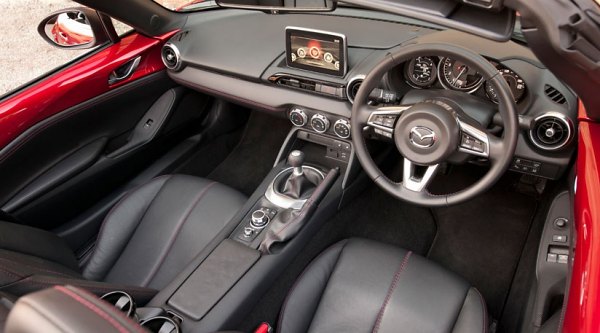 |
|
The
new cabin is not in the same league of Audi TT, but may shame Toyota 86. |
|
Visibility is excellent all round. The new cabin looks stylish and
quite well built – not in the same league of Audi TT, of course, but
may shame Toyota 86. The small steering wheel is handy, instrumentation
is clear and infotainment system is intuitive. The cabin is snug,
offering just enough room for most people except the tallest. As the
windscreen is moved back, the fabric roof can be made smaller to cut
weight. It remains to be manually operated, but the operation is
simple, requiring only one hand and just a few seconds to open or
close. Everything seems right – no more and no less.
To keep prices affordable the chassis is made of primarily steel, of
course. However, some parts in the front and rear crash structure, the
engine subframe, the bonnet, front fenders and boot lid are made of
aluminum, as are the steering knuckles and double-wishbone front
suspensions (the multi-link rear remain steel to benefit balance). Some
chassis parts have holes drilled to cut weight, too.
With less weight to haul, the base MX-5 may employ a smaller, 1.5-liter
Skyactiv direct injection engine. It is developed from the unit of
Mazda 2. Redline is raised to 7500 rpm, allowing the 14.0:1 compression
engine to produce 131 horsepower at 7000 rpm. Its maximum torque is
only 111 lbft, so you need to rev the engine quite hard to realize 0-60
mph in 7.8 seconds. However, that is also part of the joy of driving
the MX-5, especially when it has the best 6-speed manual gearbox in the
world, thanks to close ratios, short throws and slick gearchange.
Dual-clutch? No, thanks. The small engine also allows the use of
smaller (16-inch) wheels, narrower (195/50) tires and smaller brakes,
which in turn save more weight. This engine makes a lot of sense on
Japanese home soil.
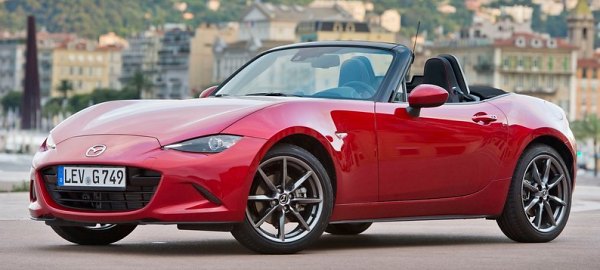 |
|
The
MX-5 is old-school. It corners with pronounced body roll, but then you
will find the car has very good inherent balance despite the roll.
|
|
But it is not enough to American drivers, of course. To satisfy them,
Mazda serves them with a 2.0 Skyactiv engine with 155 hp and 148 lbft
of torque. The car gains 25 kg, but it comes with 17-inch wheels shod
with 205 tires, Bilstein dampers and limited slip differential. The
extra mid-range torque allows the driver to extract performance less
hard, if not as effortlessly as modern turbocharged cars. 0-60 mph can
be accomplished in just over 6 seconds, which is not exactly
eye-popping these days but noticeably faster than the last generation.
It does lose a bit of high-revving sensation though compared with the
1.5. What about European? They get the best of both worlds as both
engines are available for choose. Sadly, neither motors produce very
good sound.
You won’t buy an MX-5 for straight-line speed. Neither for cornering
speed nor lap time. Modern sports cars and hot hatches are all tuned on
race tracks, so they know how to go fast in corners, i.e. by using
stiff suspensions, wide tires and powerful brakes. In contrast, the
MX-5 is old-school. It corners with pronounced body roll. At first you
might doubt if it is really a sports car. Hold on, and you will realize
the roll actually gives you an idea how hard it is cornering and how
close it gets to the limit, which is part of the information you need
to engage with the car. Then you will find the car has very good
inherent balance despite the roll. With little weight at the nose and a
quick, 2.5-turn electric power steering, it turns effortlessly into
corner. The electric helm might lack true feel, but it responds
accurately and weighs up linearly once it has overcome the initial
calmness deliberately programmed to enhance straight line stability.
Moreover, because its tire grip doesn’t overwhelm engine power, you
will be able to access oversteer on a back road at moderate speeds, all
depends on how deep you plant your right foot. It is therefore
immensely engaging and fun to drive in the real world.
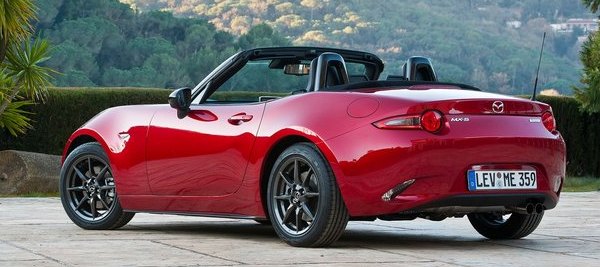 |
|
It
has no direct competitors on the sports car market.
|
|
The MX-5 is all about balance, not just chassis balance but also the
balance between power and chassis. In the current generation of sports
cars, only Toyota 86 / Subaru BRZ duo is worth comparison. The Toyobaru
has tighter body control and a more progressive handling setup, thus it
is the drift King. But the Mazda feels lighter and more nimble. It is
slightly faster, too. Better still, the MX-5 is an all-round package.
It has a more supple ride, a better gearbox, a classier cabin and an
open roof yet it costs less than the Toyobaru to buy and to run. In
fact, it has no direct competitors on the sports car market.
It is clear that the MX-5 is not for everyone – those pursuing outright
speed or lap time will never appreciate its tuning approach, which has
its sweet zone lowered to sensible road speeds at the price of ultimate
performance. Those used to rock-steady body control or flat
turbocharged torque curve may dislike it, too. Perhaps it is time for
us to rethink what makes a good sports car. Mazda is brave to tell us
that the whole car industry is running on the wrong path. The world
needs more back-to-basics affordable sports car desperately, certainly
not more 1000 horsepower supercars.
|
Verdict:      |
Published
on 18
Jan 2016
|
All rights reserved.
|
|
MX-5 RF
|
|
 |
|
As
in the cases of BMW Z3 and Z4 M Coupe, sometimes I find an odd
proportion could be attractive.
|
|
You should remember the
last generation Mazda MX-5 RC (Roadster Coupe). Its retractable metal
roof added little weight but brought better noise insulation and a
visual sensation when being opened or closed. It sold well, usually
outstripping the roadster. No wonder the same concept returns to the
ND.
Though the concept is similar, the implementation is different. Since
the new MX-5 has a shorter trunk, it cannot accommodate a full
retractable metal roof anymore, so it has to switch to a Targa-style
roof. This means, when the roof is stored, a pair of flying buttresses
is left behind the seats. As the car looks like a fastback from the
side, Mazda calls it RF or Retractable Fastback. It is not a real
fastback though, as the rear glass window is vertically mounted right
behind the cockpit. It recalls my memory of many mid-engined Ferraris
in my childhood, Jaguar XJS as well as the 1992 Honda CRX Del Sol. The
Mazda's long-hood, short-deck proportion fails to repeat the aesthetic
of Ferraris or Jaguar, of course. However, as in the cases of BMW Z3
and Z4 M Coupe, sometimes I find an odd proportion could be attractive.
The roof mechanism operates like Porsche 911 Targa: at a press of a
button, the flying buttresses rise high up in the air, revealing a
large opening. The aluminum roof panel splits in 2 pieces, one stack
above another and stow into the boot accompanied with the small rear
window. Then the flying buttresses return to the original position. It
is an elegant mechanism, taking little space – boot volume loses only 3
liters compared with the soft-top – and only 13 seconds to complete the
process. It adds only 45 kg to the kerb weight yet that already
includes some extra sound deadening materials exclusive to the RF. As a
result, performance is barely influenced. The 2.0-liter car takes just
a tenth longer to go from rest to 60 mph, while 1.5-liter car suffers
an extra 0.3 seconds. On the road, you will be hard pressed to tell the
difference.
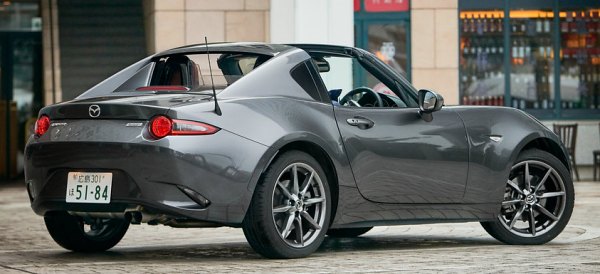
|
|
While
the Targa design keeps wind buffeting in the cockpit low, it does not
manage turbulence as well as the roadster.
|
|
Because of the roof, the RF has a higher center of gravity. To
compensate, Mazda stiffened its suspension slightly and retuned its
steering. When driving back to back with the roadster, you should find
it marginally less sharp to steer, but it retains the open-top’s
balance, sensitivity to throttle and feedback, part of the
latter comes from its pronounced body roll. Fans of the open car will
continue to love it, while critics will continue to criticize its soft
suspension and low cornering limit.
As before, its biggest selling point should be refinement. With the
roof up, the cockpit is quieter than the case of soft top. When the
roof is down, the story is not as good. While the Targa design keeps
wind buffeting in the cockpit low, it does not manage turbulence as
well as the roadster or the old RC. At highway speed, the wind noise is
so loud that
not only conversation becomes impossible, but the roar is so fierce
that you can’t help stopping the car and closing the roof. This problem
robs the MX-5 RF the chance as a highway cruiser. Therefore, the
roadster is still the better car – marginally faster and sharper, no
less livable, and 10 percent cheaper.
|
Verdict:     |
Published
on 15
Aug 2018
|
All rights reserved.
|
|
MX-5 new engine (2018)
|
|
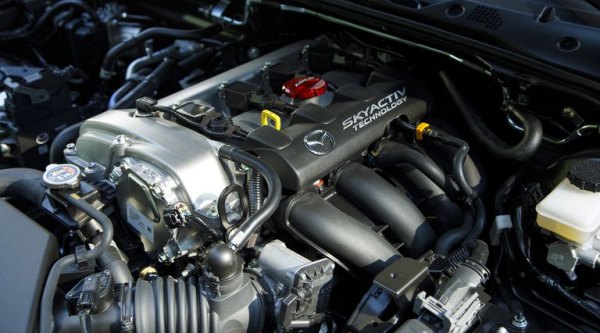
|
|
Heavily
modified 2.0 motor gives MX-5 a new lease of life.
|
|
The ND MX-5 was originally
designed to accept only the 1.5-liter motor. It is a perky motor
capable of revving to 7500 rpm, but 131 horsepower and 111 pound-foot
of torque are not enough to please American motorists. Under the
request of Mazda America, Hiroshima added the 2-liter engine at the
last minute. As it was developed in a rush, it was practically the
Mazda 3’s 2-liter engine turned north-south mounting. This explains why
it produced its peak power at a rather low 6000 rpm, and it struggled
to reach its rev limit of 6800 rpm. Its peak power of 160hp, or 155hp
for America, was also a little disappointing, especially beside the
200hp Toyota 86 or Subaru BRZ. If not the MX-5 weighs only a ton, it
would have been the Achilles’ heel. Anyway, in Europe where both motors
are available, motoring journalists preferred the smaller motor for its
eager character.
Now the embarrassing situation is over. 3 years after launch, the MX-5
is finally given a 2-liter engine it deserves. The new Skyactiv-G
engine is still based on the outgoing unit, but many components have
been modified. Firstly, to allow it revs higher, reciprocating parts
have been lightened. Each piston cuts 27 grams thanks to smaller
skirts. Each connecting rod is 40g lighter. A stiffer (but no heavier)
crankshaft allows the motor to spin faster yet with less vibration.
Then, to increase power, breathing to the combustion chambers is
enhanced. There are larger valves, larger throttle bodies, larger
intake and exhaust manifolds. Exhaust cam timing and lift have been
revised, too. Furthermore, the direct injection gets higher pressure to
allow quicker and more precise pre-combustion injections, while
reshaped combustion chambers and pistons improve tumble flow. They
combine to enhance knock resistance hence low-rpm torque output. As a
result, the new engine produces 184 horsepower (DIN/JIS), 24hp more
than before without ever resorting to increased capacity or
turbocharging. Its peak power is released at 7000 rpm instead of 6000
rpm, a night and day difference. Redline is now 7500 rpm, the same as
its 1.5-liter sibling. Moreover, its torque spread is improved, too.
There is a bit more torque throughout the rev range. Peak torque
arrives 600 rpm earlier than before at 4000 rpm, and it is 3 lbft more.
On the road, the new MX-5 should be 0.2 or 0.3 seconds quicker to go
from 0-60 mph. It is still no fireball in the seas of 300hp
turbocharged hot hatches, but the way you feel is definitely a huge
improvement. The new motor revs more freely and eagerly. While the old
engine has its power tails off noticeably after 6000 rpm, the new one
keeps revving sweetly beyond 7000 rpm. This gives you more flexibility,
as you no longer need to upshift early. A new lightweight dual-mass
flywheel also helps dampening transmission shocks and makes gearshift a
little smoother.
The rest of the MX-5 is practically unchanged, save a few improved
equipment. Its suspension tuning is kept intact, which means more body
roll in corners than the norm of performance cars. However, the MX-5
has always been designed such that you can enjoy oversteer at modest
speeds on regular roads. If you test it like motoring journalists on
race tracks, it would be nonsense. Many people do not understand its
philosophy and keep asking why not it adopts a stiffer suspension or
adaptive dampers. The MX-5 does not need recalibration, but the critics
do.
|
Verdict:      |
|